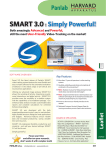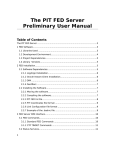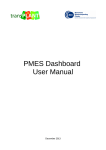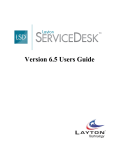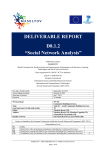Download Installation Manual
Transcript
COMP Superscalar Installation Manual Version: 1.3 November 24, 2015 This manual only provides information about how to install and configure COMPSs. Specifically, it details the installation process for Debian based distributions and for RedHat based distributions, and the steps to configure COMPSs properly. If you are not wondering to install COMPSs please consider using our already prepared Virtual Machine available at our webpage: http://compss.bsc.es . For further information about the application execution please refer to the COMPSs User Manual: Application execution guide available at http://compss.bsc.es . For further information about the application development please refer to the COMPSs User Manual: Application development guide available at http://compss.bsc.es/ . For full COMPSs application examples (codes, execution commands, results, logs, etc.) please refer to the COMPSs Sample Applications available at http://compss.bsc.es/ . i Contents 1 COMP Superscalar (COMPSs) 1 2 Packages description 2.1 Packages structure . . . . . . . . . . . . . . . . . . . . . . . . . . . . . . . 2.2 Packages Dependencies . . . . . . . . . . . . . . . . . . . . . . . . . . . . . 2 2 3 3 Debian-based distributions 3.1 Prerequisites . . . . . . . . 3.2 Package Repository . . . . 3.3 Installation . . . . . . . . 3.4 Post installation . . . . . . . . . . 4 4 4 4 7 . . . . . . . . . . . . . . . . . . . . . . . . . . . . . . . . . . . . . . . . . . . . . . . . . . . . . . . . . . . . . . . . . . . . . . . . . . . . . . . . . . . . . . . . . . . . . . . . . . . . . . . . 4 RedHat-based distributions (zypper) 4.1 Prerequisites . . . . . . . . . . . . . . 4.2 Package Repository . . . . . . . . . . 4.3 Installation . . . . . . . . . . . . . . 4.4 Post installation . . . . . . . . . . . . . . . . . . . . . . . . . . . . . . . . . . . . . . . . . . . . . . . . . . . . . . . . . . . . . . . . . . . . . . . . . . . . . . . . . . . . . . . . . . . . . . . . 8 8 8 8 10 5 RedHat-based distributions (yum) 5.1 Prerequisites . . . . . . . . . . . . 5.2 Package Repository . . . . . . . . 5.3 Installation . . . . . . . . . . . . 5.4 Post installation . . . . . . . . . . . . . . . . . . . . . . . . . . . . . . . . . . . . . . . . . . . . . . . . . . . . . . . . . . . . . . . . . . . . . . . . . . . . . . . . . . . . . . . . . . . . . . 12 12 12 12 14 . . . . 6 Supercomputers . . . . 15 7 Additional Configuration 16 7.1 Configure SSH passwordless . . . . . . . . . . . . . . . . . . . . . . . . . . 16 7.2 Configure the COMPSs Cloud Connectors . . . . . . . . . . . . . . . . . . 17 7.2.1 OCCI (Open Cloud Computing Interface) connector . . . . . . . . . 17 8 COMPSs Removal 18 8.1 How to uninstall or remove COMPSs . . . . . . . . . . . . . . . . . . . . . 18 8.2 How to clean repositories . . . . . . . . . . . . . . . . . . . . . . . . . . . . 18 ii 1 COMP Superscalar (COMPSs) COMP Superscalar (COMPSs) is a programming model which aims to ease the development of applications for distributed infrastructures, such as Clusters, Grids and Clouds. COMP Superscalar also features a runtime system that exploits the inherent parallelism of applications at execution time. For the sake of programming productivity, the COMPSs model has four key characteristics: • Sequential programming: COMPSs programmers do not need to deal with the typical duties of parallelization and distribution, such as thread creation and synchronization, data distribution, messaging or fault tolerance. Instead, the model is based on sequential programming, which makes it appealing to users that either lack parallel programming expertise or are looking for better programmability. • Infrastructure unaware: COMPSs offers a model that abstracts the application from the underlying distributed infrastructure. Hence, COMPSs programs do not include any detail that could tie them to a particular platform, like deployment or resource management. This makes applications portable between infrastructures with diverse characteristics. • Standard programming languages: COMPSs is based on the popular programming language Java, but also offers language bindings for Python and C/C++ applications. This facilitates the learning of the model, since programmers can reuse most of their previous knowledge. • No APIs: In the case of COMPSs applications in Java, the model does not require to use any special API call, pragma or construct in the application; everything is pure standard Java syntax and libraries. With regard the Python and C/C++ bindings, a small set of API calls should be used on the COMPSs applications. 1 2 2.1 Packages description Packages structure Despite the fact that we recommend users to install the complete COMPSs Framework, we have built different packages to allow users customize as maximum as possible their installation. Figure 1 illustrates the COMPSs packaging structure and its internal dependencies. Figure 1: COMPSs packaging structure 2 2.2 Packages Dependencies Next we provide a list of dependencies for each COMPSs package. The exact names may vary depending on the Linux distribution but this list provides a general overview of the COMPSs dependencies. For specific information about your distribution please check the Depends section at your package manager (apt, yum, zypper, etc.). COMPSs Framework compss-runtime, compss-cloud COMPSs Runtime compss-engine, compss-worker COMPSs Engine openjdk-7-jre, graphviz, xdg-utils COMPSs Worker openjdk-7-jre COMPSs Bindings compss-bindings-common, compss-c-binding, compsspython-binding COMPSs Bindings Common compss-engine, openjdk-7-jre COMPSs Python Binding compss-bindings-common, libpython2.7 COMPSs C/C++ Binding compss-binding-common, openjdk-7-jre, automake, libtool, libboost-serialization-dev, libboost-iostreamsdev COMPSs Tools compss-extrae, compss-monitor COMPSs Extrae compss-engine, openjdk-7-jre, libxml2-dev (>= 2.5), gfortran COMPSs Monitor compss-engine, openjdk-7-jre COMPSs Cloud compss-engine, openjdk-7-jre 3 compss-bindings, python compss-tools, (>= libxml2 (>= 2.7), 2.5), 3 Debian-based distributions 3.1 Prerequisites The commands described on the following sections require root privileges and Internet connection. Once the installation process is finished, please log out and back in again to complete the installation. 3.2 Package Repository To add the package repository you can easily download our predefined lists by executing the following command: ubuntu x86_64 : wget http :// compss . bsc . es / releases / repofiles / repo_deb_ubuntu_x86 -64. list -O / etc / apt / sources . list . d / compss - framework_x86 -64. list ubuntu noarch : wget http :// compss . bsc . es / releases / repofiles / r e p o _ d e b _ u b u n t u _ n o a r c h . list -O / etc / apt / sources . list . d / compss - f r a m e w o r k _n o a r c h . list debian x86_64 : wget http :// compss . bsc . es / releases / repofiles / repo_deb_debian_x86 -64. list -O / etc / apt / sources . list . d / compss - framework_x86 -64. list debian noarch : wget http :// compss . bsc . es / releases / repofiles / r e p o _ d e b _ d e b i a n _ n o a r c h . list -O / etc / apt / sources . list . d / compss - f r a m e w o r k _n o a r c h . list Next you need to add the repository key by executing: wget - qO - http :// compss . bsc . es / repo / debs / deb - gpg - bsc - grid . pub . key | apt - key add - And finally, refresh the apt-get repositories: apt - get update 3.3 Installation This section describes how to install all the available COMPSs packages. If you are willing to have a full COMPSs installation just follow the COMPSs Framework instructions and skip directly to next section. • COMPSs Framework Contains all the COMPSs functionalities including the Runtime, all the bindings, all the tools and the cloud connectors. To install this package please run: 4 apt - get install compss - framework • COMPSs Runtime Contains the COMPSs runtime to support the native functionalities. Install this package if you only need to support Java applications. To install this package please run: apt - get install compss - runtime This package is composed of two sub-packages: – COMPSs Engine Contains the COMPSs Engine, essential to run COMPSs applications as master. To install this package please run: apt - get install compss - engine – COMPSs Worker Contains the minimum installation required to run a machine as a COMPSs worker. To install this package please run: apt - get install compss - worker • COMPSs Bindings Contains all the required bindings for C/C++ and Python applications. To install this package please run: apt - get install compss - bindings This package is composed of three sub-packages: – COMPSs Bindings Common Contains the API required for the communication between any binding and the COMPSs Runtime. It is necessary for any binding installation. To install this package please run: 5 apt - get install compss - bindings - common – COMPSs C/C++ Binding Contains the C/C++ Binding To install this package please run: apt - get install compss -c - binding – COMPSs Python Binding Contains the Python Binding To install this package please run: apt - get install compss - python - binding • COMPSs Tools Contains all the COMPSs Tools. To install this package please run: apt - get install compss - tools This package is composed of three sub-packages: – COMPSs Extrae Contains the COMPSs Extrae tool needed to generate and process application traces. To install this package please run: apt - get install compss - extrae – COMPSs Monitor Contains the COMPSs Monitor tool needed to monitor the application execution. To install this package please run: apt - get install compss - monitor 6 • COMPSs Cloud Contains all the COMPSs Connectors needed to interact with the Cloud. To install this package please run: apt - get install compss - cloud 3.4 Post installation Once your COMPSs package has been installed remember to log out and back in again to end the installation process. If you need to set up your machine for the first time please take a look at Section 7 for a detailed description of the additional configuration. 7 4 RedHat-based distributions (zypper) 4.1 Prerequisites The commands described on the following sections require root privileges and Internet connection. Once the installation process is finished, please log out and back in again to complete the installation. 4.2 Package Repository To add the package repository you can easily download our predefined lists by executing the following command: x86_64 noarch : : zypper addrepo -f http :// compss . bsc . es / repo / rpms / stable / suse / x86_64 compss zypper addrepo -f http :// compss . bsc . es / repo / rpms / stable / suse / noarch compss And finally, refresh the repositories: zypper refresh 4.3 Installation This section describes how to install all the available COMPSs packages. If you are willing to have a full COMPSs installation just follow the COMPSs Framework instructions and skip directly to next section. • COMPSs Framework Contains the all COMPSs functionalities including the Runtime, all the bindings, all the tools and the cloud connectors. To install this package please run: zypper install compss - framework • COMPSs Runtime Contains the COMPSs runtime to support the native functionalities. Install this package if you only need to support Java applications. To install this package please run: zypper install compss - runtime 8 This package is composed of two sub-packages: – COMPSs Engine Contains the COMPSs Engine, essential to run COMPSs applications as master. To install this package please run: zypper install compss - engine – COMPSs Worker Contains the minimum installation required to run a machine as a COMPSs worker. To install this package please run: zypper install compss - worker • COMPSs Bindings Contains all the required bindings for C/C++ and Python applications. To install this package please run: zypper install compss - bindings This package is composed of three sub-packages: – COMPSs Bindings Common Contains the API required for the communication between any binding and the COMPSs Runtime. It is necessary for any binding installation. To install this package please run: zypper install compss - bindings - common – COMPSs C/C++ Binding Contains the C/C++ Binding To install this package please run: zypper install compss -c - binding 9 – COMPSs Python Binding Contains the Python Binding To install this package please run: zypper install compss - python - binding • COMPSs Tools Contains all the COMPSs Tools. To install this package please run: zypper install compss - tools This package is composed of three sub-packages: – COMPSs Extrae Contains the COMPSs Extrae tool needed to generate and process application traces. To install this package please run: zypper install compss - extrae – COMPSs Monitor Contains the COMPSs Monitor tool needed to monitor the application execution. To install this package please run: zypper install compss - monitor • COMPSs Cloud Contains all the COMPSs Connectors needed to interact with the Cloud. To install this package please run: zypper install compss - cloud 4.4 Post installation Once your COMPSs package has been installed remember to log out and back in again to end the installation process. 10 If you need to set up your machine for the first time please take a look at Section 7 for a detailed description of the additional configuration. 11 5 RedHat-based distributions (yum) 5.1 Prerequisites The commands described on the following sections require root privileges and Internet connection. Once the installation process is finished, please log out and back in again to complete the installation. 5.2 Package Repository To add the package repository you can easily download our predefined lists by executing the following command: x86_64 : wget http :// compss . bsc . es / releases / repofiles / repo_rpm_centos_x86 -64. repo -O / etc / yum . repos . d / compss - framework_x86 -64. repo 5.3 Installation This section describes how to install all the available COMPSs packages. If you are willing to have a full COMPSs installation just follow the COMPSs Framework instructions and skip directly to next section. • COMPSs Framework Contains the all COMPSs functionalities including the Runtime, all the bindings, all the tools and the cloud connectors. To install this package please run: yum install compss - framework • COMPSs Runtime Contains the COMPSs runtime to support the native functionalities. Install this package if you only need to support Java applications. To install this package please run: yum install compss - runtime This package is composed of two sub-packages: 12 – COMPSs Engine Contains the COMPSs Engine, essential to run COMPSs applications as master. To install this package please run: yum install compss - engine – COMPSs Worker Contains the minimum installation required to run a machine as a COMPSs worker. To install this package please run: yum install compss - worker • COMPSs Bindings Contains all the required bindings for C/C++ and Python applications. To install this package please run: yum install compss - bindings This package is composed of three sub-packages: – COMPSs Bindings Common Contains the API required for the communication between any binding and the COMPSs Runtime. It is necessary for any binding installation. To install this package please run: yum install compss - bindings - common – COMPSs C/C++ Binding Contains the C/C++ Binding To install this package please run: yum install compss -c - binding – COMPSs Python Binding Contains the Python Binding To install this package please run: 13 yum install compss - python - binding • COMPSs Tools Contains all the COMPSs Tools. To install this package please run: yum install compss - tools This package is composed of three sub-packages: – COMPSs Extrae Contains the COMPSs Extrae tool needed to generate and process application traces. To install this package please run: yum install compss - extrae – COMPSs Monitor Contains the COMPSs Monitor tool needed to monitor the application execution. To install this package please run: yum install compss - monitor • COMPSs Cloud Contains all the COMPSs Connectors needed to interact with the Cloud. To install this package please run: yum install compss - cloud 5.4 Post installation Once your COMPSs package has been installed remember to log out and back in again to end the installation process. If you need to set up your machine for the first time please take a look at Section 7 for a detailed description of the additional configuration. 14 6 Supercomputers The COMPSs Framework can be installed in any SuperComputer by installing its packages as in a normal distribution. The packages are ready to be reallocated so the administrators can choose the right location for the COMPSs installation. However, if the administrators are not willing to install COMPSs through the packaging system, we also provide a COMPSs zipped file containing a pre-build script to easily install COMPSs. For such purpose please execute the following commands: # Check out the last COMPSs release $ wget http :// compss . bsc . es / repo / sc / stable / COMPSs_1 .3. tar . gz # Unpackage COMPSs $ tar - xvzf COMPSs_1 .3. tar . gz # Install COMPSs at your preferred target location $ cd COMPSs $ ./ install < targetDir > # Clean downloaded files $ rm -r COMPSs $ rm COMPSs_1 .3. tar . gz The installation script will create a COMPSs folder inside the given < targetDir > so the final COMPSs installation will be placed under the < targetDir > /COM P Ss folder. Please note that if the folder already exists it will be automatically erased. In order to successfully run the installation script some dependencies must be present on the target machine. Administrators must provide the correct installation and environment of the following software: • Autotools • BOOST • Java 7 JRE The following environment variables must be defined: • JAV A HOM E • BOOST CP P F LAGS This installation provides a compssenv file that loads the required environment to allow users work more easily with COMPSs. Thus, after the installation process we recomend to source the < targetDir > /COM P Ss/compssenv into the users .bashrc. For further information about either the installation or the usage please check the README file inside the package. 15 7 Additional Configuration 7.1 Configure SSH passwordless By default, COMPSs uses SSH libraries for communication between nodes. Consequently, after COMPSs is installed on a set of machines, the SSH keys must be configured on those machines so that COMPSs can establish passwordless connections between them. This requires to install the OpenSSH package (if not present already) and follow these steps in each machine: 1. Generate an SSH key pair $ ssh - keygen -t dsa 2. Distribute the public key to all the other machines and configure it as authorized For every other available machine ( MACHINE ) : $ scp ~/. ssh / id_dsa . pub MACHINE :./ myDSA . pub $ ssh MACHINE " cat ./ myDSA . pub >> ~/. ssh / a ut ho r iz ed _k e ys ; rm ./ myDSA . pub " 3. Check that passwordless SSH connections are working fine For every other available machine ( MACHINE ) : $ ssh MACHINE For example, considering the cluster shown in Figure 2, users will have to execute the following commands to grant free ssh access between any pair of machines: me@localhost :~ $ ssh - keygen -t id_dsa # Granting access localhost -> m1 . bsc . es me@localhost :~ $ scp ~/. ssh / id_dsa . pub user_m1@m1 . bsc . es :./ me_localhost . pub me@localhost :~ $ ssh user_m1@m1 . bsc . es " cat ./ me_localhost . pub >> ~/. ssh / au th o ri ze d_ k ey s ; rm ./ me_localhost . pub " # Granting access localhost -> m2 . bsc . es me@localhost :~ $ scp ~/. ssh / id_dsa . pub user_m2@m2 . bsc . es :./ me_localhost . pub me@localhost :~ $ ssh user_m2@m2 . bsc . es " cat ./ me_localhost . pub >> ~/. ssh / au th o ri ze d_ k ey s ; rm ./ me_localhost . pub " me@localhost :~ $ ssh user_m1@m1 . bsc . es user_m1@m1 . bsc . es :~ > ssh - keygen -t id_dsa user_m1@m1 . bsc . es :~ > exit # Granting access m1 . bsc . es -> localhost me@localhost :~ $ scp user_m1@m1 . bsc . es :~/. ssh / id_dsa . pub ~/ userm1_m1 . pub me@localhost :~ $ cat ~/ userm1_m1 . pub >> ~/. ssh / au th or i ze d_ ke y s # Granting access m1 . bsc . es -> m2 . bsc . es me@localhost :~ $ scp ~/ userm1_m1 . pub user_m2@m2 . bsc . es :~/ userm1_m1 . pub me@localhost :~ $ ssh user_m2@m2 . bsc . es " cat ./ userm1_m1 . pub >> ~/. ssh / a ut ho r iz ed _k e ys ; rm ./ userm1_m1 . pub " 16 me@localhost :~ $ rm ~/ userm1_m1 . pub me@localhost :~ $ ssh user_m2@m2 . bsc . es user_m2@m2 . bsc . es :~ > ssh - keygen -t id_dsa user_m2@m2 . bsc . es :~ > exit # Granting access m2 . bsc . es -> localhost me@localhost :~ $ scp user_m2@m1 . bsc . es :~/. ssh / id_dsa . pub ~/ userm2_m2 . pub me@localhost :~ $ cat ~/ userm2_m2 . pub >> ~/. ssh / au th or i ze d_ ke y s # Granting access m2 . bsc . es -> m1 . bsc . es me@localhost :~ $ scp ~/ userm2_m2 . pub user_m1@m1 . bsc . es :~/ userm2_m2 . pub me@localhost :~ $ ssh user_m1@m1 . bsc . es " cat ./ userm2_m2 . pub >> ~/. ssh / a ut ho r iz ed _k e ys ; rm ./ userm2_m2 . pub " me@localhost :~ $ rm ~/ userm2_m2 . pub Figure 2: Cluster example 7.2 Configure the COMPSs Cloud Connectors This section provides information about the additional configuration needed for some Cloud Connectors. 7.2.1 OCCI (Open Cloud Computing Interface) connector In order to execute a COMPSs application using cloud resources, the rOCCI (Ruby OCCI) connector has to be configured properly. The connector uses the rOCCI CLI client (upper versions from 4.2.5) which has to be installed in the node where the COMPSs main application runs. The client can be installed following the instructions detailed at http: //appdb.egi.eu/store/software/rocci.cli 17 8 8.1 COMPSs Removal How to uninstall or remove COMPSs COMPSs can be easily uninstalled via the Linux Packaging Tools by running the following commands: Debian : apt - get remove compss - framework RedHat ( zypper ) : zypper remove compss - framework RedHat ( yum ) : yum remove compss - framework Notice that some of the COMPSs packages are meta-packages and, thus, you will need to manually uninstall all the COMPSs packages or use the autoremove tools: Debian : apt - get autoremove RedHat ( zypper ) : zypper remove -- clean - deps compss - framework RedHat ( yum ) : yum autoremove In Debian based distributions uninstalling COMPSs will not erase your configuration files. If you are willing to completely remove COMPSs please remember to use the purge option: Debian : apt - get purge compss - framework 8.2 How to clean repositories During the installation process you may have added the COMPSs repository. If you want to clean your respository list please erase the compss list by executing the following commands: Debian : $ rm -f / etc / apt / sources . list . d / compss - framework_ * . list $ apt - get update RedHat ( zypper ) : $ zypper removerepo compss $ zypper refresh RedHat ( yum ) : $ rm -f / etc / yum . repos . d / compss - framework_ * . repo 18 Please find more details on the COMPSs framework at http://compss.bsc.es 19






















